Jamb vs. Reveal — What's the Difference?
By Tayyaba Rehman — Updated on October 4, 2023
Jamb refers to the vertical sides of a doorway or window, often bearing loads from the structure above. Reveal is either to make something known that was secret or the side of an opening for a window, which is visible when the window is closed.

Difference Between Jamb and Reveal
Table of Contents
ADVERTISEMENT
Key Differences
Jamb and Reveal are architectural terms often used when discussing the elements of doors and windows. While a Jamb refers to the vertical parts of a door or window frame that support it in the wall, the Reveal is the side of an opening for a window or door between the outer surface of a wall and the window or door itself.
The strength and stability of any window or door largely depend on the Jamb. This structural component ensures that the fixture remains in place, providing the necessary support. On the other hand, the Reveal enhances the aesthetic and functional elements of an opening, offering depth and a certain visual appeal to windows and doors.
When installing doors and windows, the Jamb is crucial as it is what the door or window is secured to. It must be precisely aligned for the door or window to function correctly. Meanwhile, the Reveal gives insight into the wall's thickness, since it is essentially the exposed section of the wall's depth within the window or door opening.
Jamb and Reveal serve very different but equally essential purposes in architecture and construction. The Jamb ensures that a door or window is correctly anchored, allowing it to serve its primary purpose of opening and closing without hindrance. Simultaneously, the Reveal adds depth and architectural interest, affecting how the window or door relates to the rest of the wall visually.
Comparison Chart
Definition
The vertical parts of a door or window frame.
The side of a window or door opening showing the wall's thickness.
ADVERTISEMENT
Function
Provides support to the door or window.
Offers architectural depth and insight into wall thickness.
Location
Found on either side of a window or door, directly supporting it.
Lies between the outer wall surface and the window or door itself.
Importance in Installation
Must be aligned precisely for correct functioning of the door or window.
Determines aesthetic relation of the window or door to the wall.
Grammatical Use
Used as a noun in architectural context.
Also used as a noun in architectural context, but can have other meanings outside of it.
Compare with Definitions
Jamb
A jamb may refer to the side piece against which a door shuts.
The door wouldn't close properly because the jamb was warped.
Reveal
Reveal means to make known or disclose something that was previously secret.
She was hesitant to reveal the secret ingredient in her signature dish.
Jamb
In architecture, a jamb is a side post or surface of a doorway, window, or fireplace.
The locksmith had to adjust the lock mechanism within the door jamb.
Reveal
Reveal can also refer to the final exposure or disclosure of plot elements in a story or play.
The reveal at the end of the mystery novel surprised all of its readers.
Jamb
A jamb is the vertical framing that forms the sides of a doorway or window.
The door jamb was intricately carved with delicate designs.
Reveal
In construction, a reveal is the visible part of the side of a window or door opening, left exposed when the window or door is closed.
The reveal of the window was painted a contrasting color to add visual interest.
Jamb
In poetry, a jamb is a metrical foot with one unstressed followed by a stressed syllable.
In the line “To be or not to be,” the words “to be” represent a jamb.
Reveal
In television or show business, a reveal may refer to a dramatic unveiling of a product or character.
The reveal of the new product line was met with enthusiastic applause from the audience.
Jamb
In mining, a jamb may refer to an ore chute that comes to the surface.
The miners sent the extracted ore to the surface through the jamb.
Reveal
To make known (something concealed or unknown)
She revealed that she was pregnant. The study revealed the toxic effects of the pollutant.
Jamb
A jamb (from French jambe, "leg"), in architecture, is the side-post or lining of a doorway or other aperture. The jambs of a window outside the frame are called “reveals.” Small shafts to doors and windows with caps and bases are known as “jamb-shafts”; when in the inside arris of the jamb of a window they are sometimes called "scoinsons." A doorjamb, door jamb (also sometimes doorpost) is the vertical portion of the door frame onto which a door is secured.
Reveal
To cause to be seen; show
The curtains parted, revealing a ballerina. The x-ray revealed a broken bone.
Jamb
One of a pair of vertical posts or pieces that together form the sides of an opening, as for a door, window, or fireplace.
Reveal
To make known by supernatural or divine means
"For the wrath of God is revealed from heaven" (Romans 1:18).
Jamb
A projecting mass or columnar part.
Reveal
The making known of an important, secret, or salient occurrence, such as the revealing of a major development, plot twist, or visual effect in a movie
"Seeing [the Wiz] in human form in the first act diminishes the power of the reveal in the second" (Bob Verini).
Jamb
Either of the vertical components that form the side of an opening in a wall, such as that of a door frame, window frame, or fireplace.
Reveal
The part of the side of a window or door opening that is between the outer surface of a wall and the window or door frame.
Jamb
(mining) Any thick mass of rock that prevents miners from following the lode or vein.
Reveal
The whole side of such an opening; the jamb.
Jamb
Synonym of jambeau.
Reveal
The framework of a motor vehicle window.
Jamb
(transitive) To fix or attach a jamb to.
Reveal
The outer side of a window or door frame.
Jamb
The vertical side of any opening, as a door or fireplace; hence, less properly, any narrow vertical surface of wall, as the of a chimney-breast or of a pier, as distinguished from its face.
Reveal
A revelation; an uncovering of what was hidden in the scene or story.
The comedian had been telling us about his sleep being disturbed by noise. Then came the reveal: he was sleeping on a bed in a department store.
Jamb
Any thick mass of rock which prevents miners from following the lode or vein.
Reveal
(transitive) To uncover; to show and display that which was hidden.
Jamb
See Jambes.
Reveal
(transitive) To communicate that which could not be known or discovered without divine or supernatural instruction.
Jamb
Upright consisting of a vertical side member of a door or window frame
Reveal
To make known (that which has been concealed or kept secret); to unveil; to disclose; to show.
Light was the wound, the prince's care unknown,She might not, would not, yet reveal her own.
Reveal
Specifically, to communicate (that which could not be known or discovered without divine or supernatural instruction or agency).
Reveal
A revealing; a disclosure.
Reveal
The side of an opening for a window, doorway, or the like, between the door frame or window frame and the outer surface of the wall; or, where the opening is not filled with a door, etc., the whole thickness of the wall; the jamb.
Reveal
Make visible;
Summer brings out bright clothes
He brings out the best in her
The newspaper uncovered the President's illegal dealings
Reveal
Make known to the public information that was previously known only to a few people or that was meant to be kept a secret;
The auction house would not disclose the price at which the van Gogh had sold
The actress won't reveal how old she is
Bring out the truth
He broke the news to her
Reveal
Make clear and visible;
The article revealed the policies of the government
Reveal
Disclose directly or through prophets;
God rarely reveal his plans for Mankind
Reveal
Reveal can also describe the part of a tire that is visible from the side of the car.
The reveal of the tire was covered in mud after off-roading.
Common Curiosities
Can "jamb" refer to something besides architectural features?
Yes, "jamb" may also refer to a unit of measure in poetic meter or, in certain contexts, a mining term.
Can a "jamb" be a structural element?
Yes, jambs in doorways and windows are crucial for supporting the structure above them.
Are door jambs always visible?
Typically, yes. Door jambs are visible when the door is open and can be partially visible when closed.
Is "reveal" commonly used in everyday language?
Yes, "reveal" is often used to indicate the disclosure of something previously hidden, like secrets or information.
What does "reveal" mean in a narrative context?
In narratives, "reveal" often refers to the unveiling of crucial plot details or secrets.
Is a "reveal" always visual in the context of storytelling?
While reveals often include visual elements, they can also be informational or emotional.
Can "reveal" be used as a noun in construction?
Yes, "reveal" is a term used in construction to describe the visible side of an opening, like a window when closed.
Can "jamb" refer to any part of a door?
No, "jamb" specifically refers to the vertical side portions of a door or window frame.
Can "jamb" refer to both windows and doors?
Yes, "jamb" refers to the vertical components on the sides of both windows and doors.
Are jambs involved in the installation of doors and windows?
Yes, jambs are integral to the installation process, providing a place for the door or window to be secured.
Does a "reveal" always involve positive information?
No, a reveal can disclose both positive and negative information.
Can "reveal" refer to a theatrical event?
Yes, in theatre or television, a "reveal" can refer to a significant unveiling or disclosure moment.
Can a "reveal" be unintentional?
Yes, reveals can be both intentional and unintentional disclosures of information.
Do all windows and doors have jambs?
Most traditional windows and doors have jambs, but certain modern or specialized designs may not.
Share Your Discovery

Previous Comparison
Affix vs. Prefix
Next Comparison
Poly vs. SolyAuthor Spotlight
Written by
Tayyaba RehmanTayyaba Rehman is a distinguished writer, currently serving as a primary contributor to askdifference.com. As a researcher in semantics and etymology, Tayyaba's passion for the complexity of languages and their distinctions has found a perfect home on the platform. Tayyaba delves into the intricacies of language, distinguishing between commonly confused words and phrases, thereby providing clarity for readers worldwide.















































